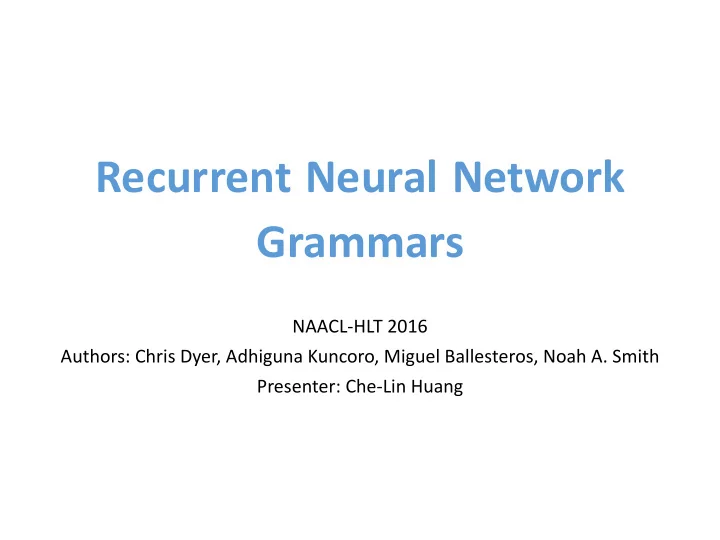

Recurrent Neural Network Grammars NAACL-HLT 2016 Authors: Chris Dyer, Adhiguna Kuncoro, Miguel Ballesteros, Noah A. Smith Presenter: Che-Lin Huang
Motivation • Sequential recurrent neural networks (RNNs) are remarkably effective models of natural language • Despite these impressive results, sequential models are not appropriate models of natural language • Relationships among words are largely organized in terms of latent nested structures rather than sequential order
Overview of RNNG • A new generative probabilistic model of sentences that explicitly models nested, hierarchical relationships among words and phrases • RNNGs maintain the algorithmic convenience of transition based parsing but incorporate top-down syntactic information • They give two variants of the algorithm, one for parsing, and one for generation: • The parsing algorithm transforms a sequence of words ! into a parse tree " • The generation algorithm stochastically generates terminal symbols and trees with arbitrary structures
Top-down variant of transition-based parsing algorithm • Begin with the stack (S) empty, the complete sequence of words in the input buffer (B), and zero number of open nonterminals on the stack (n) • Stack: terminal symbols, open nonterminal symbols, and complete constituents • Input buffer: unprocessed terminal symbols • Three classes of operations: NT(X), SHIFT, and REDUCE
Top-down variant of transition-based parsing algorithm • Terminate when both criterions meet: 1. A single completed constituent on the stack 2. The buffer is empty • Constraints on parser transitions: 1. NT(X) can only be applied if B is not empty and n < 100 2. SHIFT can only be applied if B is not empty and n ≥ 1 3. REDUCE can only be applied if n ≥ 2 or if the buffer is empty 4. REDUCE can only be applied if the top of the stack is not an open nonterminal symbol
Parser transitions and parsing example
Generation algorithm • Can be adapted from parsing algorithm with minor changes • No input buffer, instead there is an output buffer (T) • No SHIFT operation, instead there is GEN(x) operation that generate terminal symbol and add it to the top of stack and the output buffer • Constraints on generator transitions: 1. GEN(x) can only be applied if n ≥ 1 2.REDUCE can only be applied if the top of the stack is not an open nonterminal symbol and n ≥ 1
Generator transitions and generation example
Generative model • RNNGs use the generator transition set to define a joint distribution on syntax trees ( " ) and words ( ! ), which is a sequence model over generator transitions that is parameterized using a continuous space embedding of the algorithm state at each time step ( # $ ):
Syntactic composition function • The output buffer, stack, and history can grow unboundedly • To obtain representations of them, they use RNN to encode their content • Output buffer and history apply a standard RNN encoding • Stack is more complicated, use stack LSTMs to encode • To compute an embedding of this new subtree, use a composition function based on bidirectional LSTMs:
Neural architecture • Neural architecture for defining a distribution over % $ given representations of the stack ( & $ ), output buffer ( ' $ ) and history of actions ( % ($ )
Inference via importance sampling • To evaluate the generative model as a language model, we need to compute the marginal probability: ) ! = )(!, " . ) ∑ �1.∈3 • Use a conditional proposal distribution 4 " !) with properties: 1. )(!, ") > 0 ⟹ 4("|!) > 0 2. Samples y~4("|!) can be obtained efficiently 3. 4("|!) of these samples are known • Importance weights: ; !, " = )(!, ")/4("|!)
English parsing result • Parsing results on Penn Treebank • D: discriminative • G: generative • S: semisupervised • F1 score: > = 2 )@ABCDCEF×@AB%HH = )@ABCDCEF + @AB%HH ×100%
Chinese parsing result • Parsing results on Penn Chinese Treebank • D: discriminative • G: generative • S: semisupervised • F1 score: > = 2 )@ABCDCEF×@AB%HH = )@ABCDCEF + @AB%HH ×100%
� Language model result • Report per-word perplexities of three language models • Cross-entropy: L ), 4 = − N ) ! HEP Q 4(!) O • per-word perplexities : R S,T 2 U
Conclusion • The generative model is quite effective as a parser and a language model. This is the result of: • Relaxing conventional independence assumptions • Inferring continuous representations of symbols alongside non-linear models of their syntactic relationships • Discriminative model performs worse than generative model: • Larger, unstructured conditioning contexts are harder to learn from • It provide opportunities to overfit
Thank you!
Recommend
More recommend